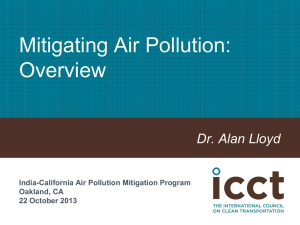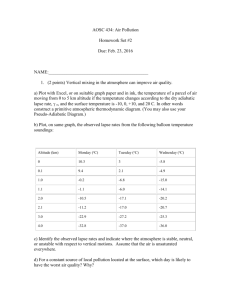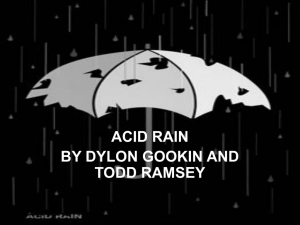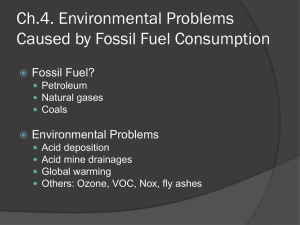Nitrogen dioxide, sulfur dioxide, and ammonia detector
advertisement
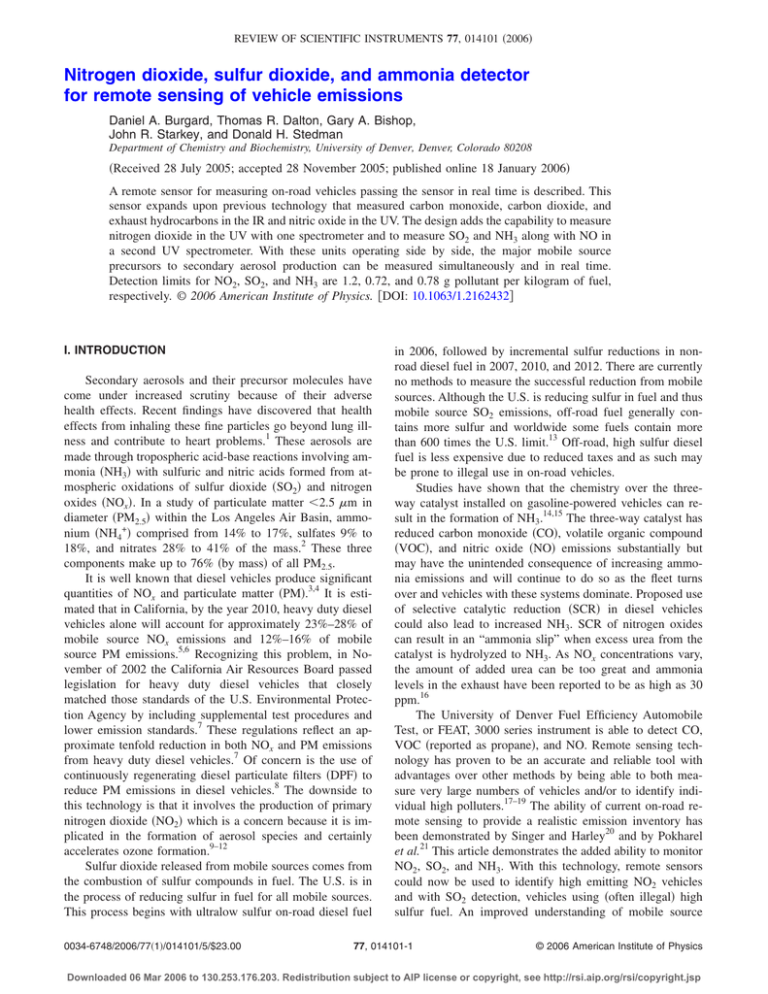
REVIEW OF SCIENTIFIC INSTRUMENTS 77, 014101 共2006兲 Nitrogen dioxide, sulfur dioxide, and ammonia detector for remote sensing of vehicle emissions Daniel A. Burgard, Thomas R. Dalton, Gary A. Bishop, John R. Starkey, and Donald H. Stedman Department of Chemistry and Biochemistry, University of Denver, Denver, Colorado 80208 共Received 28 July 2005; accepted 28 November 2005; published online 18 January 2006兲 A remote sensor for measuring on-road vehicles passing the sensor in real time is described. This sensor expands upon previous technology that measured carbon monoxide, carbon dioxide, and exhaust hydrocarbons in the IR and nitric oxide in the UV. The design adds the capability to measure nitrogen dioxide in the UV with one spectrometer and to measure SO2 and NH3 along with NO in a second UV spectrometer. With these units operating side by side, the major mobile source precursors to secondary aerosol production can be measured simultaneously and in real time. Detection limits for NO2, SO2, and NH3 are 1.2, 0.72, and 0.78 g pollutant per kilogram of fuel, respectively. © 2006 American Institute of Physics. 关DOI: 10.1063/1.2162432兴 I. INTRODUCTION Secondary aerosols and their precursor molecules have come under increased scrutiny because of their adverse health effects. Recent findings have discovered that health effects from inhaling these fine particles go beyond lung illness and contribute to heart problems.1 These aerosols are made through tropospheric acid-base reactions involving ammonia 共NH3兲 with sulfuric and nitric acids formed from atmospheric oxidations of sulfur dioxide 共SO2兲 and nitrogen oxides 共NOx兲. In a study of particulate matter ⬍2.5 m in diameter 共PM2.5兲 within the Los Angeles Air Basin, ammonium 共NH4+兲 comprised from 14% to 17%, sulfates 9% to 18%, and nitrates 28% to 41% of the mass.2 These three components make up to 76% 共by mass兲 of all PM2.5. It is well known that diesel vehicles produce significant quantities of NOx and particulate matter 共PM兲.3,4 It is estimated that in California, by the year 2010, heavy duty diesel vehicles alone will account for approximately 23%–28% of mobile source NOx emissions and 12%–16% of mobile source PM emissions.5,6 Recognizing this problem, in November of 2002 the California Air Resources Board passed legislation for heavy duty diesel vehicles that closely matched those standards of the U.S. Environmental Protection Agency by including supplemental test procedures and lower emission standards.7 These regulations reflect an approximate tenfold reduction in both NOx and PM emissions from heavy duty diesel vehicles.7 Of concern is the use of continuously regenerating diesel particulate filters 共DPF兲 to reduce PM emissions in diesel vehicles.8 The downside to this technology is that it involves the production of primary nitrogen dioxide 共NO2兲 which is a concern because it is implicated in the formation of aerosol species and certainly accelerates ozone formation.9–12 Sulfur dioxide released from mobile sources comes from the combustion of sulfur compounds in fuel. The U.S. is in the process of reducing sulfur in fuel for all mobile sources. This process begins with ultralow sulfur on-road diesel fuel 0034-6748/2006/77共1兲/014101/5/$23.00 in 2006, followed by incremental sulfur reductions in nonroad diesel fuel in 2007, 2010, and 2012. There are currently no methods to measure the successful reduction from mobile sources. Although the U.S. is reducing sulfur in fuel and thus mobile source SO2 emissions, off-road fuel generally contains more sulfur and worldwide some fuels contain more than 600 times the U.S. limit.13 Off-road, high sulfur diesel fuel is less expensive due to reduced taxes and as such may be prone to illegal use in on-road vehicles. Studies have shown that the chemistry over the threeway catalyst installed on gasoline-powered vehicles can result in the formation of NH3.14,15 The three-way catalyst has reduced carbon monoxide 共CO兲, volatile organic compound 共VOC兲, and nitric oxide 共NO兲 emissions substantially but may have the unintended consequence of increasing ammonia emissions and will continue to do so as the fleet turns over and vehicles with these systems dominate. Proposed use of selective catalytic reduction 共SCR兲 in diesel vehicles could also lead to increased NH3. SCR of nitrogen oxides can result in an “ammonia slip” when excess urea from the catalyst is hydrolyzed to NH3. As NOx concentrations vary, the amount of added urea can be too great and ammonia levels in the exhaust have been reported to be as high as 30 ppm.16 The University of Denver Fuel Efficiency Automobile Test, or FEAT, 3000 series instrument is able to detect CO, VOC 共reported as propane兲, and NO. Remote sensing technology has proven to be an accurate and reliable tool with advantages over other methods by being able to both measure very large numbers of vehicles and/or to identify individual high polluters.17–19 The ability of current on-road remote sensing to provide a realistic emission inventory has been demonstrated by Singer and Harley20 and by Pokharel et al.21 This article demonstrates the added ability to monitor NO2, SO2, and NH3. With this technology, remote sensors could now be used to identify high emitting NO2 vehicles and with SO2 detection, vehicles using 共often illegal兲 high sulfur fuel. An improved understanding of mobile source 77, 014101-1 © 2006 American Institute of Physics Downloaded 06 Mar 2006 to 130.253.176.203. Redistribution subject to AIP license or copyright, see http://rsi.aip.org/rsi/copyright.jsp 014101-2 Burgard et al. FIG. 1. Average of three, 1 s spectra of 498 ppm NO2 in an 8 cm cell taken with the FEAT spectrometer. NH3 contributions to emission inventories could also be available. It is noteworthy that ammonia deposition, particularly in the western United States, has increased very significantly.22 It is quite possible that this increase in ammonia deposition is due, at least partially, to the increasing percentage of catalyst equipped vehicles in the U.S. fleet. II. EXPERIMENT A. Instrument design The FEAT remote sensor has been developed and described in detail elsewhere.23,24 The FEAT system consists of a collinear UV and IR light source approximately a foot above the road surface on one side of the road that directs parallel light from a 6 in. mirror across the road to the detector. Because of turbulence behind the vehicle and the fact that ratios to CO2 are measured, exact height is unimportant. The light is focused from a mirror in the detector unit to a dichroic beam splitter 共Acton Research兲 which serves to separate the beams into their IR and UV components. The IR light is then passed onto a spinning polygon mirror that sequentially directs the light across the four nondispersive infrared detectors with bandpass filters for measurement of CO, CO2, VOC, and reference. The UV light is reflected off the surface of the beam splitter and is focused into the end of a quartz fiber-optic cable, which transmits the light to an ultraviolet spectrometer. The UV spectrometer designed by Popp et al. uses a Czerny-Turner design and detection is accomplished by a 128-element photodiode array 共PDA兲 detector 共Hamamatsu, Inc.兲.23 This spectrometer previously operated in the range of 218–234 nm, centered on the gamma band of NO at 227 nm. To incorporate the three molecular species, this spectral window needed to be expanded. Two separate spectrometers are used to detect this larger spectral window and the system can measure CO, VOC, NO, NO2, SO2, and NH3 emissions simultaneously. 1. NO2 detection Nitrogen dioxide has the largest peak-to-valley change in absorbance without interfering species in a series of peaks between 430 and 446 nm as seen in Fig. 1.11 This near-UV region of the NO2 absorbance spectrum is assigned the elec- Rev. Sci. Instrum. 77, 014101 共2006兲 FIG. 2. Comparison of detected light intensity between the traditional optics and the system described herein with the UV coated mirrors and enhanced beam splitters. Intensity at 227 nm for NO detection is slightly improved while the NH3 and SO2 region from 200 to 225 nm is enhanced such that useful results can be obtained. tronic transition of 2B1 ← 2A1.25 A shift of more than 200 nm was required to modify the spectrometer from the previous 227 nm NO peak. All that was needed to adapt to these wavelengths was to adjust the grating position. This was accomplished by machining a 5° wedge and inserting it under the grating mount to center the PDA of the spectrometer at 438 nm. 2. SO2 , NH3, and NO detection A second, separate UV spectrometer was used to measure SO2 , NH3, and NO. This spectrometer had major optical improvements made to increase its sensitivity to ultraviolet light. The second spectrometer still needs to detect NO while expanding its detection down to 200 nm. Sulfur dioxide has a series of absorption bands between 200 and 230 nm. The assignment of these bands is not straightforward but has been proposed to be two electronic transitions, C ← X and D ← X.26 Ammonia has five detectable absorbance peaks between 200 and 220 nm from the electronic transition A ← X.27 The overlapping absorbance spectra of the detected species also require software. B. Hardware improvements Hardware improvements were only significant on the spectrometer designed to measure NO, SO2, and NH3. Figure 2 shows the increased light intensity at shorter wavelengths which made detection of SO2 and NH3 possible. The increased light intensity was a result of multiple optical improvements. The light source was redesigned with an offaxis, overhead arrangement of the IR filament and UV xenon arc bulb to help eliminate thermal patterns in the transmitted light. The light source incorporates a dichroic mirror to create the collinear UV/IR light. The beam splitter 共Acton Research兲 was previously optimized for 227 nm but was replaced with one optimized at 215 nm. The difference in coatings can be seen in Fig. 2 where the 215 nm optimized splitter actually has a dip at 230 nm. The 6 in. reflecting mirror was purchased from Edmund Scientific but then sent to Acton Research Corp. for a special vacuum ultraviolet- Downloaded 06 Mar 2006 to 130.253.176.203. Redistribution subject to AIP license or copyright, see http://rsi.aip.org/rsi/copyright.jsp 014101-3 Rev. Sci. Instrum. 77, 014101 共2006兲 NO2, SO2, and NH3 vehicle remote sensor III. RESULTS A. NO2 detection FIG. 3. Spectra of the calibration cells used with the instrument. The top plot is NO 共2750 ppm cm兲, the middle is SO2 共912 ppm cm兲, and the bottom is NH3 共880 ppm cm兲. The spectra have been offset for clarity. ultraviolet 共VUV-UV兲 broadband coating. The detector unit also received an optimized beam splitter at 215 nm. The Acton mirror coating was applied to the 2 in. pickup mirror in the detector unit and to both 2 in. mirrors in the UV spectrometer.23 C. Software improvements The software previously used a base-line-corrected absorbance calculation to determine the concentration of NO. Both spectrometers now employ a nine-point, first derivative smoothing routine developed by Savitzky and Golay.28 This technique is used in the 430–446 nm spectrometer because the absorbances are small and in the 200–230 nm spectrometer where light intensity and signal-to-noise ratio are an issue. The spectrometers obtain dark, reference, and calibration spectra before vehicle measurements begin. The reference and calibration spectra are dark subtracted and the smoothing routine is applied to the calibration. Each passing vehicle is measured for 10 ms, 50 times 共0.5 s兲. Each 10 ms scan is dark subtracted, ratioed to the reference spectrum, and smoothed. These values are ratioed to the calibration smoothed values to provide pollutant concentration versus time. These data are reported to the FEAT computer for correlation to CO2 since the analysis of the emissions is a carbon-based mass analysis. The measurement and analysis are completed in less than 1 s in order for the system to report in real time and to enable measurement of vehicles closely following each other. Figure 3 shows the absorbance spectra of each species measured by the second spectrometer. SO2 is the first UV-absorbing species determined and then its contribution is subtracted from the NO and NH3 spectra. Although there is a series of SO2 peaks, the three peaks at 219, 221, and 222 nm are used because there are no other interfering species from vehicle exhaust in this region. The NH3 concentration is determined by its peaks at 209, 213, and 217 nm. The NO concentration is obtained as before from its peak at 227 nm. The FEAT NO2 remote sensor has been tested both in the laboratory and in parking lot studies. The noise level of NO2 was determined by calculating the standard deviation from the instrument response with no NO2 present in the beam path. The standard deviation was found to be 50 ppm cm. The FEAT 3000 unit and NO2 spectrometer were then set up in a parking lot and used to measure simulated emissions from a certified gas bottle 共Scott Specialty Gases兲 containing 498 ppm NO2 and 15% CO2 in N2. The mean ppm NO2 / % CO2 emission ratio from this study was 33.7± 1.1. This agrees well with the manufacturer’s specification of a ppm NO2 / % CO2 ratio of 33.2± 0.6. A light heavy duty diesel vehicle was used as a proof of concept for our studies. A 2001 diesel Dodge Ram 2500 truck was measured simultaneously with both the FEAT 3000 NO2 system and a series of onboard instruments. The onboard platform consisted of a nondispersive ultraviolet 共NDUV兲 NO/ NO2 module 共Sensors, Inc. #9110-141 Rev. B兲 linked downstream from a 5-Gas Analyzer 共WPI Micro Processor Systems兲. The vehicle was measured during steadystate passes in front of the remote sensing instrument. These measurements were matched to the corresponding measurements from the onboard instruments. The mean NO2 emissions in grams per kilogram of fuel 共g / kg兲 from the remote sensor was 9.5± 0.8 g / kg while the onboard system recorded excellent agreement at 9.2± 0.8 g / kg. B. SO2 and NH3 detection The FEAT system has been tested both in the laboratory and in a parking lot study. The noise levels for the two channels were determined by liberating a mixture of the typical vehicle exhaust gases CO2, CO, propane, and NO from a calibration bottle in front of the instrument and recording the reported SO2 and NH3 values. The reported NH3 concentrations gave a standard deviation of 32 ppm cm. The SO2 standard deviation is slightly better at 24 ppm cm but had a positive offset of 40 ppm cm. When the pollutants are present in autoexhaust, well-resolved spectra are obtained from this instrument. Figures 4共a兲 and 4共b兲 show 10 ms spectra of exhaust from behind actual cars in a parking lot. An approximation for SO2 production from fossil fuel combustion in air can be described in Eq. 共1兲. CH2 + xS + 共1.5 + x兲共O2 + 4N2兲 → CO2 + H2O + 共6 + x兲N2 + xSO2 . 共1兲 Fuel sulfur is typically in parts per million and therefore the x fraction is a very small coefficient. A vehicle using fuel containing 1000 ppm sulfur by weight at stoichiometry should produce approximately 60 ppm by volume SO2 in exhaust. The instrument’s 3 limit of detection measuring SO2 in exhaust allows for identification of a vehicle using as little as 150 ppm by weight sulfur in the fuel. The use of this technology to identify high sulfur fuel use through gross polluters of SO2 can be seen in Fig. 5. The vehicle represented by the squares is gasoline powered with fuel doped with dimethyl sulfoxide and represents a gross Downloaded 06 Mar 2006 to 130.253.176.203. Redistribution subject to AIP license or copyright, see http://rsi.aip.org/rsi/copyright.jsp 014101-4 Rev. Sci. Instrum. 77, 014101 共2006兲 Burgard et al. TABLE I. Comparison of each vehicle’s fuel sulfur content, expected SO2 emissions, and the measured average SO2 emissions. Vehicle Sulfur content in fuel 共ppm by weight兲 Expected emissions g SO2 / kg fuel Average emissions g SO2 / kg fuel ± standard deviation 共number of runs兲 2726 5.45 5 ± 2 共20兲 433 0.87 0.9± 0.3 共21兲 119 0.24 0.1± 0.2 共20兲 Sulfur-doped gasoline 1985 Chevrolet wagon Diesel 2002 VW Jetta TDI Gasoline 2001 Saab 9-3 FIG. 4. Two 10 ms spectra from separate passes of on-road vehicles in a parking lot. 共A兲 shows the three SO2 peaks 共219, 221, and 222 nm兲 used for concentration analysis. The large double peak on the right is the NO peak at 227 nm. 共B兲 shows the five NH3 peaks from 200 to 220 nm. The peaks at 209, 213, and 217 nm are used for analysis. Note that all of the nitrogen 共other than N2兲 emitted in 共B兲 is in the form of NH3. The NO peak is absent. polluter. This vehicle has significantly different emissions than the diesel vehicle 共circles兲 and the undoped gasoline vehicle 共triangles兲. The fuels used were sampled and sent out for sulfur content analysis 共Wyoming Analytical兲. Table I shows the measured fuel sulfur content from each vehicle, the expected SO2 emissions, and the average SO2 emissions. The gasoline vehicles shown in Fig. 5 are equipped with three-way catalysts and the diesel vehicle has an oxidation catalyst. Catalysts have been shown to store sulfur and release it variably according to driving mode.29 These mea- FIG. 5. Mass-based emissions plotted vs run number by the FEAT instrument. The squares represent a sulfur-doped gasoline-powered car with a catalyst, the circles represent a diesel car without a catalyst, and the triangles represent a gasoline-powered car with a catalyst. The emissions are mass based and not percentages to allow gasoline and diesel vehicles on the same plot. surements include the inherent fluctuations in driving mode. The doped gasoline and diesel vehicles both had nonzero mean SO2 emissions and nearly equal relative standard deviations of 0.34 and 0.37, respectively. These vehicles show similar variability of SO2 emissions which is most likely due to catalyst sulfur storage under some conditions. A working oxidation catalyst can further oxidize sulfur in the fuel from detectable SO2 to undetectable SO3.30 However, sulfur poisons catalytic converters. Therefore, this instrument that measures SO2 will detect a vehicle which regularly uses high sulfur fuel because the fuel will have rendered the catalyst ineffective. IV. DISCUSSION For the first time, remote sensing was used to measure NO2 and SO2 emissions directly from the exhaust plume of a passing vehicle. These two species were measured with separate instruments but a future project is to combine the two spectrometers into one unit. The NO2 on-road limit of detection has been determined by assuming that a gasolinepowered vehicle emits 共as measured兲 none of the pollutant. Using this assumption and multiple measurements, the 3 limit of detection for NO2 is 1.18 g / kg fuel or approximately 54 ppm in exhaust. This is almost an order of magnitude below the NO2 emission level for a typical light duty diesel vehicle. This is a conservative estimate since there is a small amount of NO2 emitted from a gasoline-powered vehicle. Subsequent studies have shown that optical adaptations which will provide more light to the optical fiber should lower instrument noise proportionately. The SO2 channel has the ability to detect vehicles using fuels containing differing amounts of sulfur. The on-road 3 limit of detection of SO2 is 0.72 g / kg fuel or 24 ppm in exhaust. This is also a conservative detection limit since it is based on the runs from the lowest sulfur vehicle 共119 ppm兲 which would still produce some SO2 and have some real variability in the emissions. Ammonia has been measured remotely behind passing vehicles previously.31 This previous study reported a mean concentration of 44.7 ppm on 2091 vehicles. They report negative values as low as −165 ppm. Negative readings are a result of the noise of the instrument. On-road studies using the FEAT instrument have shown the lowest negative value Downloaded 06 Mar 2006 to 130.253.176.203. Redistribution subject to AIP license or copyright, see http://rsi.aip.org/rsi/copyright.jsp 014101-5 to be −58 ppm. This noise is almost three times smaller and can be attributed to better spectral resolution from the FEAT instrument.32 The 3 on-road limit of detection of the NH3 channel is based on the standard deviation from a diesel vehicle without a three-way catalyst or SCR and is calculated at 0.78 g / kg fuel used or 33 ppm in exhaust corrected for excess air. This level of detection is more than adequate to measure NH3 from passing vehicles whether produced by the catalyst or by ammonia slip. This instrument provides the much needed ability to measure, quantify, and inventory on-road emissions of secondary aerosol precursor gases. Mandates for reductions of the oxides of nitrogen and particulate matter make DPF/SCR exhaust after treatment a popular choice. DPF/SCR employs both NO2 and NH3. The system described above can measure both gases from a large number of vehicles in real, on-road use. The SO2 channel is a tool to improve enforcement of low sulfur fuel use. This is especially useful now when the future of oil prices is uncertain and there is a great lure of illegal, lower cost, high sulfur fuel. ACKNOWLEDGMENTS The authors acknowledge Environmental Systems Products, the Coordinating Research Council, and the National Science Foundation under Grant No. ATM-0450466 for their financial support to make this project possible. C. Hogue, Chem. Eng. News 82, 19 共2004兲. B. M. Kim, S. Teffera, and M. D. Zeldin, J. Air Waste Manage. Assoc. 50, 2034 共2000兲. 3 J. H. Seinfeld, Atmospheric Chemistry and Physics of Air Pollution 共Wiley, New York, 1986兲. 4 J. B. Heywood, Internal Combustion Engine Fundamental 共McGraw-Hill, New York, 1988兲. 5 Public Hearing to Consider Amendments Adopting More Stringent Emission Standards for 2007 and Subsequent Model Year New Heavy-Duty Diesel Engines, California Air Resources Board, Sacramento, CA, 2001. 6 Public Hearing to Consider Amendments to Adopt Not-to-Exceed and Euro III European Stationary Cycle Emission Test Procedures for the 2005 and Subsequent Model Year New Heavy-Duty Diesel Engines, California Air Resources Board, Sacramento, CA, 2000. 7 Reduced Emission Standards for 2007 and Subsequent Model Year Heavy-Duty Diesel Engines, California Air Resources Board, Sacramento, CA, 2005. 1 2 Rev. Sci. Instrum. 77, 014101 共2006兲 NO2, SO2, and NH3 vehicle remote sensor 8 C. K. Reul-Chen, C. Ross, N. L. C. Steele, and A. M. Winer, J. Air Waste Manage. Assoc. 55, 241 共2005兲. 9 D. C. Carslaw and S. D. Beevers, Atmos. Environ. 38, 1233 共2004兲. 10 J. H. Shorter, S. H. Herndon, M. S. Zahniser, D. D. Nelson, J. Wormhoudt, K. L. Demerjian, and C. E. Kolb, Environ. Sci. Technol. 39, 7991 共2005兲. 11 S. Tang, L. Graham, L. Shen, X. Zhou, and T. Lanni, Environ. Sci. Technol. 38, 5968 共2004兲. 12 S. S. Butcher and R. L. Charlson, An Introduction to Air Chemistry 共Academic, New York, 1972兲. 13 K. O. Blumberg, M. P. Walsh, and C. Pera, Low-Sulfer Gasoline and Diesel: The Keys to Lower Vehicle Emissions, report prepared for the International Council on Clean Transportation meeting, Napa, CA, May 2003, p. 30, available at http://www.cleantranspotationcouncil.org 14 M. Shelef and H. S. Gandhi, Ind. Eng. Chem. Prod. Res. Dev. 11, 2 共1972兲. 15 M. Shelef and H. S. Gandhi, Ind. Eng. Chem. Prod. Res. Dev. 11, 393 共1972兲. 16 G. Lenaers and M. Van Poppel, 13th World Clean Air and Environmental Protection Congress, London, UK, 22–27 August 2004 共unpublished兲. 17 D. R. Lawson, P. J. Groblicki, D. H. Stedman, G. A. Bishop, and P. L. Guenther, J. Air Waste Manage. Assoc. 40, 1096 共1990兲. 18 G. A. Bishop, D. H. Stedman, J. E. Peterson, T. J. Hosick, and P. L. Guenther, Air Waste 43, 978 共1993兲. 19 California Bureau of Automotive Repair, Remote Sensing Device High Emitter Identification with Confirmatory Roadside Inspection, available at http://www.feat.biochem.du.edu/links.html 20 B. C. Singer and R. A. Harley, J. Air Waste Manage. Assoc. 46, 581 共1996兲. 21 S. S. Pokharel, G. A. Bishop, and D. H. Stedman, Atmos. Environ. 36, 5177 共2002兲. 22 National Atmospheric Deposition Program Home Page, http:// nadp.sws.uiuc.edu 共accessed July 2005兲. 23 P. J. Popp, G. A. Bishop, and D. H. Stedman, J. Air Waste Manage. Assoc. 49, 1463 共1999兲. 24 P. L. Guenther, D. H. Stedman, G. A. Bishop, S. P. Beaton, J. H. Bean, and R. W. Quine, Rev. Sci. Instrum. 66, 3024 共1995兲. 25 A. E. Douglas and K. P. Huber, Can. J. Phys. 43, 74 共1965兲. 26 G. Hertzberg, Molecular Structure and Molecular Structure III, Electronic Structure of Polyatomic Molecules 共Van Nostrand, Princeton, NJ, 1966兲. 27 H. Okabe, Photochemistry of Small Molecules 共Wiley, New York, 1978兲. 28 A. Savitzky and M. J. E. Golay, Anal. Chem. 36, 1627 共1964兲. 29 M. M. Maricq, R. E. Chase, N. Xu, and D. H. Podsiadlik, Environ. Sci. Technol. 36, 276 共2002兲. 30 M. M. Maricq, R. E. Chase, N. Xu, and P. M. Laing, Environ. Sci. Technol. 36, 283 共2002兲. 31 M. M. Baum, E. S. Kiyomiya, S. Kumar, A. M. Lappas, V. A. Kapinus, and H. C. Lord III, Environ. Sci. Technol. 35, 3735 共2001兲. 32 Air Instruments and Measurements, Inc., A Novel Vehicle Exhaust Remote Sensing Instrument for Fast, Multi-Component Analysis, AB 2766/ 96028, Baldwin Park, CA, March 2000, p 94. Downloaded 06 Mar 2006 to 130.253.176.203. Redistribution subject to AIP license or copyright, see http://rsi.aip.org/rsi/copyright.jsp

